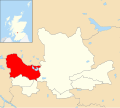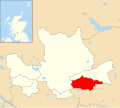Top Qs
Timeline
Chat
Perspective
East Dunbartonshire
Council area of Scotland From Wikipedia, the free encyclopedia
Remove ads
East Dunbartonshire (Scots: Aest Dunbartanshire; Scottish Gaelic: Siorrachd Dhùn Bhreatann an Ear, pronounced [ˈʃirˠəxk ɣum ˈpɾʲɛht̪ən̪ˠ əɲ ˈɛɾ]) is one of the 32 council areas of Scotland. It borders Glasgow City Council Area to the south, North Lanarkshire to the east, Stirling to the north, and West Dunbartonshire to the west. East Dunbartonshire contains many of the suburbs in the north of Greater Glasgow, including Bearsden, Milngavie, Bishopbriggs, Kirkintilloch, Lenzie, Twechar, Milton of Campsie, Balmore, and Torrance, as well as some other of Glasgow's commuter towns and villages. The council area covers parts of the historic counties of Dunbartonshire, Lanarkshire, and Stirlingshire.
The council area was formed in 1996, as a result of the Local Government etc. (Scotland) Act 1994, from the former Bearsden and Milngavie districts and most of the former Strathkelvin district, which had been part of the Strathclyde region.
Remove ads
History
East Dunbartonshire was created in 1996 under the Local Government etc. (Scotland) Act 1994, which abolished the regions and districts which had been created in 1975, replacing them with unitary council areas. East Dunbartonshire covered the area of the abolished Bearsden and Milngavie and Strathkelvin districts (except the Chryston and Auchinloch area from the latter, which went to North Lanarkshire). Both former districts had been in the Strathclyde region.[3]
Both of East Dunbartonshire's predecessor districts had been created in 1975 under the Local Government (Scotland) Act 1973. The Bearsden and Milngavie district had been created covering Milngavie, Bearsden and adjoining areas from Dunbartonshire. The Strathkelvin district had been created covering Kirkintilloch and adjoining areas from Dunbartonshire, Bishopbriggs and adjoining areas from Lanarkshire, and the parishes of Baldernock and Campsie from Stirlingshire.[4]
Remove ads
Demographics
East Dunbartonshire council area has low levels of deprivation, with relatively low unemployment and low levels of crime. The population is both declining and ageing.[5]
In a 2007 Reader's Digest poll, East Dunbartonshire was voted the best place in Britain to raise a family.[6] The area has generally performed well in the Halifax Quality of Life survey; in 2010 it was ranked third in Scotland,[7] and it was the only Scottish area in the British Top 20 in 2008.[8] A Legatum Prosperity Index published by the Legatum Institute in October 2016 showed East Dunbartonshire as the most prosperous council area in Scotland and the ninth most prosperous in the United Kingdom.[9]
Remove ads
Communities
The area is divided into thirteen community council areas, twelve of which have community councils as at 2023 (being those with asterisks in the list below):[10]
- Baldernock*
- Bearsden East*
- Bearsden North*
- Bearsden West*
- Bishopbriggs*
- Campsie*
- Kirkintilloch*
- Lenzie*
- Milngavie*
- Milton of Campsie*
- Torrance*
- Twechar
- Waterside*
Governance
Summarize
Perspective
Political control
The first election to East Dunbartonshire Council was held in 1995, initially operating as a shadow authority alongside the outgoing authorities until the new system came into force on 1 April 1996. Political control of the council since 1996 has been as follows:[12]
Leadership
The first leader of the council, Charles Kennedy, had been the last leader of the old Strathkelvin District Council. The leaders of East Dunbartonshire Council since 1996 have been:[citation needed]
Composition
Following the 2022 election, allegiance changes, and the 2024 by-election, the council composed:[14]
The next election is due in 2027.
Premises
Since 2012 the council has been based at 12 Strathkelvin Place in Kirkintilloch, which forms part of the Southbank Marina development adjoining the Forth and Clyde Canal. Prior to 2012 the council was based at Tom Johnston House at the junction of Lenzie Road and Civic Way in Kirkintilloch. Tom Johnston House had been built in 1985 as the headquarters for the old Strathkelvin District Council and was named after Tom Johnston (1881–1965), who was born in Kirkintilloch and had served as Secretary of State for Scotland during the Second World War.[15] Tom Johnston House was demolished in 2015.[16] The new council chamber at Strathkelvin Place is called Tom Johnston Chamber.[17]
Remove ads
Elections
Summarize
Perspective
Since 2007 elections have been held every five years under the single transferable vote system, introduced by the Local Governance (Scotland) Act 2004. Election results since 1995 have been as follows:[12]
Wards

Since 2007, the council (as with all others in Scotland) has been elected using multi-member wards, each returning three councillors using a single transferable vote system of proportional representation. Initially this retained the number of councillors at 24 following on from the same number of single-member wards in previous elections, divided equally across eight wards. However, a national boundary and population review prior to the 2017 Scottish local elections led to the number of East Dunbartonshire wards being reduced to seven and the number of councillors being reduced to 22. These current wards are:[23]
Remove ads
Settlements
Largest settlements by population:
Remove ads
Places of interest
- Campsie Fells
- West Highland Way
- Forth and Clyde Canal
- Antonine Wall
- Mugdock Country Park
- Milngavie water treatment works
- River Kelvin
- Lillie Art Gallery
- Auld Kirk Museum
- Huntershill Village
- The Fort Theatre
- The Turret Theatre
- The Gadloch
- Thomas Muir Cairn - Erected by John SL Watson and unveiled by East Dunbartonshire's Provost John Dempsey (1997)
- Scottish Political Martyrs Gate - Erected by John SL Watson and unveiled by East Dunbartonshire's Provost John Dempsey (1997)
- Miners of the world memorial hutch - created by John SL Watson and unveiled by leader of East Dunbartsonshire Council John Morrison (2003)
- Finger Post marking the Old Glasgow-Stirling postal road
- Huntershill Village Mile Stone
- Southwest view across Gadloch Towards the distant Red Road Flats.
Remove ads
Education
There are 8 secondary schools and 33 primary schools in the area.[25][26] The secondary schools are:
References
External links
Wikiwand - on
Seamless Wikipedia browsing. On steroids.
Remove ads




















